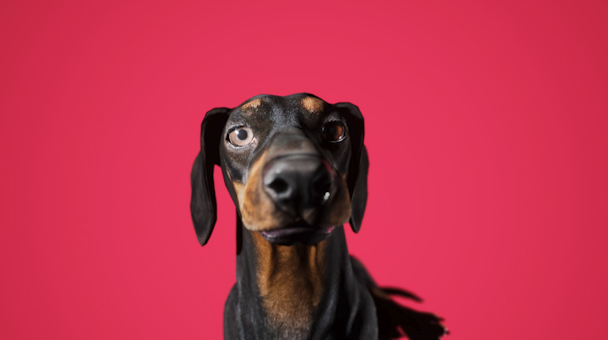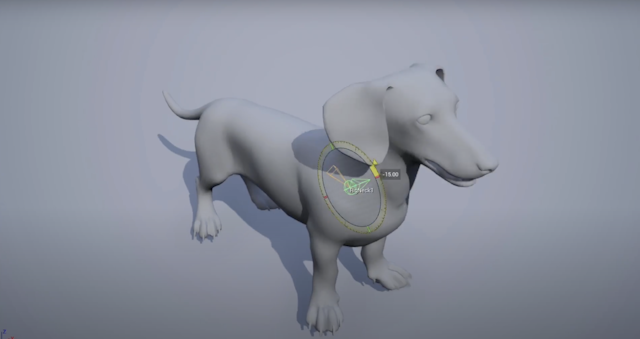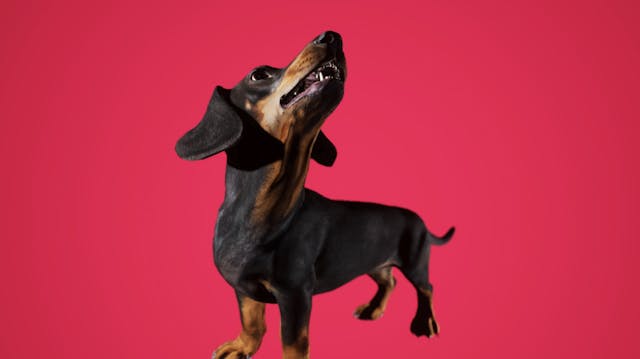With dachshund mascot due a refresh, Vitality has turned to a digital canine clone
VCCP digital agency Bernadette created a digital replica to replace sausage dog behind long-time brand mascot.

The new Stanley, in his digital dachshund glory / VCCP/Vitality
Stanley the dachshund has been the plodding face of health insurance brand Vitality for nine years. His shining coat and curious eyes suggest an accessible, manageable concept of wellness: healthy, not hench. But the canine actors behind Stanley do not benefit from eternal youth.
In previous years, the course of action available to Vitality and its creative agency partner VCCP would have been clear, just as it was to Metro Goldwyn Mayer (MGM) when its management had to find feline replacements for Leo the Lion. Between 1917 and 1958, the movie studio employed eight different big cats as its mascot. Indeed, several sausage dogs have taken on the role of Vitality brand hero since Stanley’s debut.
Advertisement
But casting for the right replacement takes precious time – and relying on footage of a real dog can be limiting in the context of today’s multi-channel campaigns. Digital video ads for Vitality previously had to re-use footage shot for TV or repeat shots of Stanley leaping and running, a limit on its palette.
VCCP’s customer experience arm, Bernadette, has pursued an alternative route. It has created a digital dachshund, a composite sausage dog made from images and footage of Stanley’s most recent dog actor, and two other canines that can play the brand mascot in most digital environments.
“Modern progressive production techniques have allowed us to create photo-realism at speed – something that was not possible a few years ago,” says Jon Bancroft, creative director at Bernadette.
Advertisement
Using CG modeling and photorealistic animation, he and chief design officer Jonny Goodall have created a replacement that can provide a greater diversity and quantity of marketing assets than could ever have been culled from ordinary footage of Stanley.
“Using only video assets from a shoot can limit a brand’s creativity in social and digital comms, as well as make it difficult to use the brand asset in any interactive technology,” says Bancroft.
Goodall, meanwhile, adds: “Stanley is a core brand resource for Vitality. We wanted to ensure he is flexible, customizable and able to perform any move in any sequence needed for both launch and future campaign opportunities.”
Suggested newsletters for you
The agency has been experimenting with incorporating the same techniques used to create a brand mascot for animation (the agency also works with O2, for example, which uses a cute robot to market itself) to see if they could be merged directly into the video and TV production workflow.
“Internally, people were starting to take notice of the fact we could not only produce a character but use it in our digital channels, keeping the work in-house and allowing for reactive, channel-specific content,” says Goodall.

Given the solution might yield the capability to create more marketing assets faster than before possible, it won over Vitality’s marketing team.
The change means that Stanley “shows off his personality and tells the Vitality story,“ according to Keith Kropman, the insurer’s chief marketing officer. The canine’s latest incarnation “embodies the brand and our role as a progressive insurer,” he adds.
The only misgiving was the difficulty with rendering his coat. Given the amount of computing power required to simulate the realistic movement of fur and hair, it’s a frequent sticking block for virtual production methods. “There were some small concerns around the use of photorealism but these were quickly reassured after sharing the first renders,” says Bancroft.
Firstly, the team had to generate a vast amount of Stanley imagery in a photoshoot that captured his every angle. Then, an existing wireframe model of a dachshund was altered to fit Stanley’s tubular silhouette and dressed with a fur texture derived from a photoshoot. “After a bit of back and forth, we rigged a skeleton up to him and then he was ready to animate,” says Bancroft.

“The trick was to create Stanley, not just any dachshund, so after initially starting with a basic model, we then needed to make sure that Stanley’s personality, markings, leg size and facial features that are unique to him were all there,” adds Bancroft. The job took the team around four weeks, but Bancroft says that nascent AI generative animation could speed that up in the future.
Bancroft and Goodall are keen to ensure that their clone of Stanley retains his personality. “The trick with all characters like this is to stick to the moves that the subject would physically be able to do or you run into issues with the movements looking unnatural,” says Goodall. That means showing restraint in some of the animated movements he might make. A moonwalking animation, they explain, was nixed because a real sausage dog wouldn’t be able to pull off the dance. A trip down a playpark slide, though difficult for a flesh and blood pooch, was judged to be on the right side of physics.
On TV, Stanley is currently played by two lookalike dachshunds. Bernadette’s virtual production method could be extended to TV or cinema-grade assets, says Goodall, but that application would have been “overkill” for Vitality’s current brief and its overall media strategy. He expects that virtual production could replace real brand dog actors in time, though.
“The best part of our production is that it can output to low poly formats (games and AR) but we can output to a higher spec. The resolution we needed for this job was for social and web, but that doesn’t mean we can’t export to a higher quality.
“It would have been overkill for the brief to output at cinema standard, but just because that was the request and quality for this brief, it doesn’t mean he can’t be rendered at a higher scale ready for broadcast. It’s an important point: what your brief is versus what it’s capable of.”
Update (6 Feb). An earlier version of this story stated there had been a single dog portraying Stanley for the last nine years.

